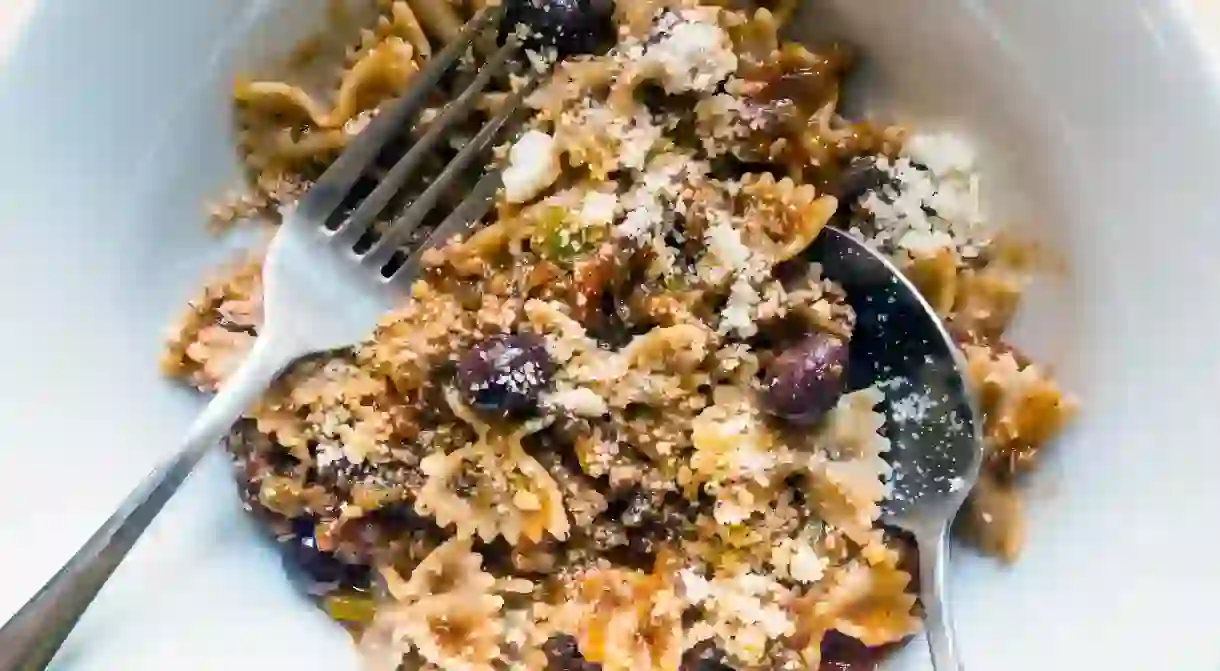A Region-By-Region Guide To Italian Pasta

Known for its diverse palate and regional cuisine, Italy’s culinary identity can be quite difficult to define. But pasta forms an integral part of its gastronomical personality and comes in a variety of different shapes and sizes. From the ‘priest-hats’ of the north to the ‘bridegrooms’ of the south, here is a region-by-region guide to Italian pasta.
Agnolotti: Piedmont
Most commonly crimped, square-shaped and stuffed with meat, agnolotti (or ‘priest hats’) is the primary pasta of Piedmont, in the northwestern region of Italy. Located in the lush-green foothills of the Alps and the Apennines, and surrounded by a wooded wilderness, Piedmontese cuisine is typically tinged with the musky aromas of its mountainous backdrop. Perfect for poaching, agnolotti can also be added to a broth, but are best pan-fried in a sage and butter sauce and finished off with a dusting of white truffle.

Farfalle: Lombardy
Universally recognised as the ‘bow-tie’, farfalle borrows its name from the Italian word for ‘butterflies’. Despite its intricate design, this good-looking variety remains the signature pasta of the northwestern Italian region of Lombardy. Habitually blended with beetroot, spinach or squid-ink, farfalle is also available in an array of brilliant colour combinations to include the vivid hues of the Italian flag. Owing to its sauce-holding-abilities, this pasta is best served with a simple tomato and basil concoction.

Curzetti Stampae: Liguria
Originating from the pastel-coloured coastal stretch of the Italian Riviera, curzetti stampae (or Corzetti stamps), are a fresh pasta unique to the northwestern Italian region of Liguria. Often referred to as, sroxetti, crosetti, or cruxettu, curzetti stampae became fashionable during the Italian Renaissance, when noble families would stamp their heraldic badge on their pasta. Conventionally coin-shaped, curzetti stampae are embossed with an elaborate design, which is effected by a specialised artisanal hand-stamp. Commonly coated in a meat sauce, curzetti stampae also marry well with pesto genovese (Ligurian basil pesto).

Strozzapreti: Emilia Romagna
Strozzapreti, (or ‘priest-choker’), is a hand-rolled variety of pasta from the northern Italian region of Emilia-Romagna. Its dubious name origin is unclear; one legend suggests that ‘Strozzapreti’ stems from the story of the gluttonous priests who choked on their pasta as a result of their insatiable appetite, another claims that housewives ‘choked’ the dough in such a rage, violent enough to ‘choke a priest’. Irregular in size and shape, strozzapreti is the larger version of cavatelli (‘little hollows’), and is made of flour, water, parmigiano-reggiano, and egg whites.

Gigli: Tuscany
Gigli, (or ‘lilies’), is a type of dried pasta from the lush-green patch-worked pastures of Tuscany, in Central Italy. Honouring the Giglio (‘lily’) of Florence, this Toscanini triumph dates back to the Italian Renaissance – a time when Florentine gastronomy was plush and profuse. Not only does this beautiful bouquet of pasta look stunning on the plate; but, with its delicately ruffled edges and fluted form, it is also adept at capturing thick and creamy sauces. For something lighter, though, try mixing it with fresh zucchini, garlic, and parmigiano-reggiano.

Bucatini: Lazio
Bucatini (from Italian ‘buco’ meaning ‘hole’), is a spaghetti-like pasta with a hollow centre, that derives from the central Italian region of Lazio. Closely related to macaroni, (another cylindrical pasta), the stretched-out tubular structure of bucatini – made of hard durum wheat flour – makes it robust and versatile and pretty much perfect for any sauce. Principally complimented by full-bodied flavours, its seemly size and shape also makes it ideal for baking, and teams up particularly well with mozzarella and meatballs.

Spaghetti alla Chitarra: Abruzzo
Spaghetti alla chitarra is a variety of egg pasta from the Abruzzo region of Central Italy. Unlike the better-known cylindrical form, alla chitarra is square-shaped. As the etymology of its name suggests, spaghetti alla chitarra is fashioned by a ‘chitarra’, (or a ‘guitar’), which when draped in fresh pasta, is pressed with a rolling-pin, and plucked to form a bundle of perfectly shaped strings on the sloped platform below. Best served al dente, this pasta is customarily co-ordinated with an Abruzzese ragu.

Penne: Campania
Penne (or ‘pen’) is a well-known variety of Italian pasta that is said to have arisen from the south of Italy, in the region of Campania. Otherwise known as ‘quills’, this tubular Napolese variety is cut diagonally at the ends, which creates its quill-pen likeness. Available in other sizes – ‘pennette’ (smaller penne) and ‘pennioni’ (bigger penne) – this pasta can also be smooth, or ridged (penne rigate). Ideal with heavy sauces, penne is traditionally served with a flavourful arrabbiata (spicy tomato sauce).

Orecchiette: Puglia
Head southeast to Italy’s ‘heel’ and you will find the pasta speciality of Puglia: ‘orecchiette’ (or ‘little ears’). This home-made, durum wheat variety has a somewhat hazy history, but with its concave thumbprint, this exemplary sauce holder forms a principle part of Pugliese cuisine. Influenced by the region’s agricultural tradition, the typical way to eat orecchiette, in Puglia, is with broccoli rabe (grown in the area), and is often referred to as orecchiette alle cime di rapa (orecchiette with turnip tops).

Ziti: Sicily
Ziti (or ‘bride-grooms’) is the chunkier Sicilian version of Campanian penne, from the rugged, southernmost region of Italy. Generally, three or four inches long, and hollowed out, ziti can also have a ridged exterior (ziti rigati), which makes it the perfect accompaniment to a thick sauce. Owing to its size and durability, this staple of Sicilian cuisine is typically baked in marinara sauce (tomato-based), and combined with ricotta and mozzarella cheese; but it can also be supplemented by a salad, or served with asparagus, pesto and a good handful of walnuts.














